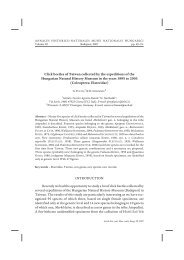Notes on some new and interesting bryophyte records from Croatia
Notes on some new and interesting bryophyte records from Croatia
Notes on some new and interesting bryophyte records from Croatia
You also want an ePaper? Increase the reach of your titles
YUMPU automatically turns print PDFs into web optimized ePapers that Google loves.
272 BRYOLOGICAL NOTES<br />
Journal of Bryology (2009) 31: 272–275 Received 10 March 2009. Revisi<strong>on</strong> accepted 14 July 2009<br />
# British Bryological Society 2009 DOI: 10.1179/037366809X12469790518448<br />
<str<strong>on</strong>g>Notes</str<strong>on</strong>g> <strong>on</strong> <strong>some</strong> <strong>new</strong> <strong>and</strong> <strong>interesting</strong> <strong>bryophyte</strong> <strong>records</strong> <strong>from</strong> <strong>Croatia</strong><br />
The <strong>bryophyte</strong> flora of South-Eastern Europe (as defined<br />
by Sabovljević et al. 2008) is poorly known compared with<br />
<strong>some</strong> other regi<strong>on</strong>s of Europe. However, there has been<br />
c<strong>on</strong>siderable progress recently, although not equally across<br />
all countries <strong>and</strong> regi<strong>on</strong>s. Many <strong>bryophyte</strong> species are<br />
known <strong>on</strong>ly <strong>from</strong> single or a few localities in a particular<br />
regi<strong>on</strong> or country <strong>and</strong> most of the recorded data are more<br />
than 50 years old.<br />
Bryologically, <strong>Croatia</strong> is <strong>on</strong>e of the best-known regi<strong>on</strong>s<br />
of the former Yugoslavia <strong>and</strong> together with Romania <strong>and</strong><br />
Slovenia is quite rich in <strong>bryophyte</strong>s, although even in these<br />
countries, as stated by Sabovljević et al. (2001), not all<br />
regi<strong>on</strong>s have been equally well investigated <strong>and</strong> <strong>some</strong> areas<br />
are bryologically unknown or poorly known. There have<br />
been almost no bryological investigati<strong>on</strong>s in recent times in<br />
<strong>Croatia</strong>. Some <strong>bryophyte</strong>s have been recorded as part of<br />
wider investigati<strong>on</strong>s (Rac & Lovrič, 1989; Rac, 2003;<br />
Habdija et al., 2004), but <strong>on</strong>ly very few studies deal directly<br />
with the <strong>bryophyte</strong>s (Kučera, 1998; Pericin & Hürlimann,<br />
2001). Data <strong>on</strong> the <strong>bryophyte</strong> flora of <strong>Croatia</strong> can also be<br />
found in Pavletić (1955, 1968), Martinčič (1968), Düll<br />
(1983, 1984, 1985, 1992), Düll et al. (1999), Suanjak (2002)<br />
<strong>and</strong> Horvat & Plaziblat (2007) <strong>and</strong> have been c<strong>on</strong>solidated<br />
in the check-lists of Sabovljević (2003, 2006), Sabovljević &<br />
Natcheva (2006), Ros et al. (2007) <strong>and</strong> Sabovljević et al.<br />
(2008). These latter publicati<strong>on</strong>s were used for evaluating<br />
bryological novelties for <strong>Croatia</strong>.<br />
The present paper reports <strong>records</strong> of 12 mosses <strong>new</strong> for<br />
<strong>Croatia</strong> based <strong>on</strong> specimens found in the Collecti<strong>on</strong> of the<br />
Hungarian Natural History Museum, Budapest (Bryophyte<br />
herbarium BP). Many of these samples were collected a<br />
l<strong>on</strong>g time ago. With these data, the <strong>bryophyte</strong> flora of<br />
<strong>Croatia</strong> now numbers 644 species in total, of which 487 are<br />
mosses. Of the <strong>bryophyte</strong> species reported <strong>from</strong> <strong>Croatia</strong> by<br />
Sabovljević et al. (2001), 22 (7 hepatics <strong>and</strong> 15 mosses) are<br />
red-listed in Europe (ECCB, 1995). Our research has added<br />
three further red-listed species (Anomod<strong>on</strong> rostratus,<br />
Brachyd<strong>on</strong>tium trichodes, Taxiphyllum densifolium).<br />
Nomenclature follows Hill et al. (2006). Unless otherwise<br />
stated, all identificati<strong>on</strong>s have been c<strong>on</strong>firmed or revised by<br />
B. Papp.<br />
Anomod<strong>on</strong> rostratus (Hedw.) Schimp.<br />
Lika-Krbava. Mali Ablaj, <strong>on</strong> the way to Kozinj, <strong>on</strong><br />
calcareous rocks (‘Mali Ablaj, …zu Kozinj, Kalkfelsen’), ca<br />
750 m, 05.07.1912, leg., det. J. Baumgartner (BP no. 52820).<br />
Lika-Krbava. Senjsko Bilo above Krasno <strong>on</strong> calcareous<br />
rocks (‘über Krasno an Kalkfelsen’), ca 1200 m,<br />
08.07.1912, leg., det. J. Baumgartner (BP no. 52821).<br />
Central Mt Velebit. Sveto Brdo opposite to St. Rok, <strong>on</strong><br />
calcareous rocks (‘Sveto Brdo gegen Sv. Rok, an<br />
Kalkfelsen’), 650–700 m, 17.06.1912, leg., det. J.<br />
Baumgartner (BP no. 52822).<br />
North Mt Velebit. Brušane opposite to Crni Vrh, mixed<br />
substrate (‘gegen den Crni Vrh zu, gemischte Unterlage’),<br />
600–700 m, 27.06.1912, leg. J. Baumgartner, det. B. Papp,<br />
separated <strong>from</strong> specimen of Taxiphyllum wisgrillii (BP<br />
no. 51461b).<br />
Mt Velebit. In a rock fissure between Brušane <strong>and</strong> Oštrija<br />
‘In rupium fissuris inter Brušane et Oštarija’), ca 900 m,<br />
11.08.1906, leg., det. J. Baumgartner (BP no. 52817).<br />
Mt Velebit. On rocks between Brušane <strong>and</strong> Oštrija (‘In<br />
rupestribus inter Brušane et Oštrijam’), ca 800 m,<br />
30.07.1908, leg., det. J. Baumgartner (BP no. 52818).<br />
Mt Velebit. In the Ramino-Coršto valley near Oštarija<br />
(‘Velebit valle Ramino-Coršto pr. Oštarijam socio. Hyp.<br />
Mollusco’), 25.06.1908, leg., det. J. Baumgartner (BP no. 52819).<br />
This is a submediterranean, m<strong>on</strong>tane species (Düll,<br />
1985). The European centre of its distributi<strong>on</strong> is in<br />
Central <strong>and</strong> Eastern Europe (ECCB, 1995). It occurs <strong>on</strong><br />
shaded calcareous rocks, in rock crevices. This species is<br />
red-listed in Europe, included in the ‘rare’ category in the<br />
Red Data Book of European Bryophytes (ECCB, 1995).<br />
According to Sabovljević et al. (2008) in SE Europe it is<br />
present in Bulgaria, Romania, Serbia <strong>and</strong> Slovenia.<br />
Brachyd<strong>on</strong>tium trichodes (F.Weber) Milde<br />
Rijeka. On shaded schistose rocks near Fužine (‘Comit.<br />
Modrus-Fiume ad saxa schist. umbrosa prope Fužine’),<br />
700 m, 06.10.1968, leg., det. Á. Boros sub nom. Seligeria<br />
setacea (S. recurvata), rev. L. Gos (BP no. 96941).<br />
This is a subatlantic, m<strong>on</strong>tane species (Düll, 1984). It<br />
occurs <strong>on</strong> shaded, n<strong>on</strong>-calcareous rocks. According to<br />
Sabovljević et al. (2008) in SE Europe it is present in<br />
Bosnia-Herzegovina, Bulgaria, Romania <strong>and</strong> Slovenia.<br />
Because of its small size <strong>and</strong> preferred microhabitat in<br />
rock crevices, this species is frequently overlooked. It is<br />
included in the Red Data Book of European Bryophytes<br />
(ECCB, 1995) in the ‘rare’ category.<br />
Brachytheciastrum olympicum (Jur.) V<strong>and</strong>erporten et al.<br />
Mt Velebit. On the slopes of the hill Sveto Brdo (Holly<br />
Hill) above St. Rok (‘In declivibus m<strong>on</strong>tis Sveto Brdo supra<br />
Sv. Rok’), ca 1000 m, 22.07.1907, leg. Á. Degen, det. J.<br />
Baumgartner sub nom. B. velutinum (BP no. 56362).<br />
This is a submediterranean species (Düll, 1985), closely<br />
related to B. velutinum. According to Sabovljević et al.<br />
(2008) in SE Europe it is known <strong>from</strong> Bosnia-Herzegovina,<br />
Maced<strong>on</strong>ia, Romania, Slovenia <strong>and</strong> Turkish Thrace. It has<br />
also been reported <strong>from</strong> Greece by Ade & Koppe (1955)<br />
<strong>and</strong> Gamisans & Hébrard (1979, 1980), though not<br />
included in Sabovljević et al. (2008).<br />
Bryum pallens Sw. ex. An<strong>on</strong>.
BRYOLOGICAL NOTES 273<br />
Central Mt Velebit. Bunjevačka Draga above Raduč, <strong>on</strong><br />
calcareous rocks (‘Bunjevačka Draga über Raduč, an<br />
Kalkfelsen’), ca 950 m, 19.06.1912, leg., det. J.<br />
Baumgartner (BP no. 39827).<br />
Dalmatia. Mt Velebit. On the hill Debelo brdo, above<br />
Seline (‘In m<strong>on</strong>te Debelo brdo supra Seline’), ca 900 m,<br />
23.06.1912, leg. J.B. Kümmerle, det. J. Baumgartner (BP<br />
no. 39819) <strong>and</strong> 27.06.1912, leg. J.B. Kümmerle, det. J.<br />
Baumgartner (BP no. 39820).<br />
North Mt Velebit. Kozjak by Kozin, calcareous rocks.<br />
(‘Kozjak bei Kozin. Kalk’), ca 1050 m, 06.07.1912, leg., det.<br />
J. Baumgartner (BP no. 39828).<br />
Mt Velebit. In rocky places between St. Rok <strong>and</strong> Mali<br />
Kalan (‘In rupestribus inter Sveti Rok et Mali Kalan’),<br />
24.07.1907, leg. Á. Degen, det. J. Baumgartner (BP no. 39821).<br />
South Mt Velebit. St. Rok by Mali Kalan, calcareous<br />
rocks (‘Sv. Rok n. Mali Kalan. Kalkfelsen’), ca 1000 m,<br />
16.06.1912, leg., det. J. Baumgartner (BP no. 39829).<br />
Mt Velebit. On Mt Crljeni Kuk by Medak (‘In m<strong>on</strong>te<br />
Crljeni Kuk ad Medak’), ca 1500 m, 12.08.1909, leg. Á.<br />
Degen, det. J. Baumgartner (BP no. 39822).<br />
Mt Velebit. Poljana by St. Ivan (Lika) by Medak (‘Pojana<br />
ad Svetog Ivana (Lika) ad Medak’), ca 600 m, 14.08.1909,<br />
leg. Á. Degen, det. J. Baumgartner (BP no. 39824).<br />
Mt Velebit. On shaded rocks of the peak Vaganski Vrh<br />
above Raduč (‘In rupestribus umbrosis m<strong>on</strong>tis Vaganski<br />
Vrh supra Raduč’), 03.08.1906, leg. Á. Degen, det. J.<br />
Baumgartner (BP no. 39823).<br />
This is a boreal species (Düll, 1984) frequently found in wet<br />
places, in springs, <strong>on</strong> stream banks in mountain areas.<br />
According to Sabovljević et al. (2008) in SE Europe it is known<br />
<strong>from</strong> all countries except Bosnia-Herzegovina <strong>and</strong> <strong>Croatia</strong>.<br />
Callierg<strong>on</strong>ella lindbergii (Mitt.) Hedenäs<br />
Mt Velebit. On the hill Sladikovac near Oštrija (‘In<br />
m<strong>on</strong>te Sladikovac pr. Oštarijam’), ca 1200 m, 17.07.1907,<br />
leg. Á. Degen, det. J. Baumgartner (BP no. 48166).<br />
Mt Velebit. On the hill Vratnik near Senj ‘In jugo<br />
Vratnik prope Senj’), 13.08.1910, leg. Á. Degen, det. J.<br />
Baumgartner (BP no. 48167).<br />
This is a boreal species (Düll, 1985) with a circumpolar distributi<strong>on</strong>.<br />
In SE Europe it is present in Bulgaria, Greece,<br />
M<strong>on</strong>tenegro, Romania, Serbia <strong>and</strong> Slovenia (Sabovljević et al.<br />
2008).<br />
Grimmia dissimulata E. Maier<br />
Dalmatia. Isl<strong>and</strong> of Hvar, wet stream gorge above Dol<br />
by Stari Grad, <strong>on</strong> sunny calcareous rocks (‘Insel Lesina<br />
(Hvar), Giessbachschlucht über Dol bei Citta Vecchia an<br />
s<strong>on</strong>nigem Kalkgestein’), 200–300 m, 19.03.1904, leg., det. J.<br />
Baumgartner sub nom. G. lisae (BP no. 36461).<br />
This species was recently described by Maier (2002). It<br />
occurs <strong>on</strong> exposed calcareous rocks, <strong>and</strong> its distributi<strong>on</strong> is<br />
incompletely known. In SE Europe it was already known<br />
<strong>from</strong> Greece <strong>and</strong> M<strong>on</strong>tenegro.<br />
Grimmia hartmanii Schimp.<br />
Lika-Krbava. Poljana by St. Ivan at the foot of Mt<br />
Velebit by Medak, siliceous rocks (‘Poljana ad Sv. Ivana<br />
am Fusse des Velebit bei Medak, Silikatgestein’), ca 650 m,<br />
21.06.1912, leg., det. J. Baumgartner (BP no. 175903).<br />
Lika-Krbava. Stream gorge in the hills of Mt Velebit<br />
above Raduč valley, siliceous rocks (‘Bachschlucht in den<br />
Vorbergen des Velebit über Raduč Tal Silikat’), 650 m,<br />
18.06.1912, leg., det. J. Baumgartner (BP no. 175905).<br />
Lika-Krbava. Valley of Kruščica stream by St. Rok at the<br />
foot of Mt Velebit, siliceous rocks (‘Tal des Kruščica-Baches<br />
bei Sv. Rok am Fusse des Velebit; am Silikatgestein’), 570 m,<br />
17.06.1912, leg., det. J. Baumgartner (BP no. 175904).<br />
North Mt Velebit. Brušane, woody stream gorge opposite<br />
to Crni vrh, siliceous rocks ‘Brušane, waldige Bachschlucht<br />
gegen den Crni vrh zu: Silikatgestein’), 650–900 m,<br />
27.06.1912, leg., det. J. Baumgartner (BP no. 36441).<br />
Mt Velebit. In the valley Jažine by Brušane (‘In valle<br />
Jažine ad Brušane’, 19.09.1913, leg. Á. Degen, det. J.<br />
Baumgartner (BP no. 6170, 36440).<br />
It is a subboreal-m<strong>on</strong>tane species (Düll, 1984) with wide<br />
circumpolar distributi<strong>on</strong>. It is frequently found <strong>on</strong> shaded<br />
acidic rocks. Our specimens were collected <strong>from</strong> siliceous<br />
rocks. According to Sabovljević et al. (2008) it is recorded<br />
in all other South-East European countries.<br />
Palustriella falcata (Brid.) Hedenäs<br />
Lika, by Poljana at St. Ivan near Medak (‘ad Pojana ad<br />
Svetog Ivana pr. Medak’), ca 600 m, 19.07.1909, leg., det.<br />
Á. Degen (BP no. 55770).<br />
Mt Velebit. Poljana by St. Ivan near the foot of the Mt<br />
Velebit near Medak (‘Poljana ad Sv. Ivana ad pedem m<br />
Velebit prope Medak’), 24.08.1910, leg. Á. Degen, det. J.<br />
Baumgartner (BP no. 55775).<br />
Mt Velebit. In the valley Počiteljska Draga near Počitelj<br />
(‘In valle Počiteljska Draga prope Počitelj’), 13.08.1909, leg.<br />
Á. Degen, det. J. Baumgartner (BP no. 55774).<br />
Mt Velebit. In wet meadows Bunjevačka poljana under<br />
Mali Malovan (‘In pratis humidis Bunjevačka Pojana sub.<br />
M. Malovan’), ca 1000 m, 1908.07.28, leg. Á. Degen, det. J.<br />
Baumgartner (BP no. 55773 <strong>and</strong> 55776).<br />
Central Velebit. In Bunjevac, Malovan <strong>on</strong> calcarous rock<br />
(‘im Bunjevac, Malovan, Kalk’), ca 1200, 19.06.1912, leg.,<br />
det. J. Baumgartner (BP no. 55764).<br />
This is a frequent species of calcareous springs <strong>and</strong><br />
streams in the temperate z<strong>on</strong>e of Europe (Düll, 1985) with a<br />
Eurasian distributi<strong>on</strong>. According to Sabovljević et al.<br />
(2008) in SE Europe it is recorded in almost all countries<br />
except Bosnia-Herzegovina, <strong>Croatia</strong> <strong>and</strong> Maced<strong>on</strong>ia.<br />
Plagiothecium nemorale Mitt. A. Jaeger<br />
North Mt Velebit. Brušane, in Oale opposite to Crni Vrh,<br />
mixed substrate (‘Brušane, im Oale gegen den Crni Vrh zu,<br />
gemischte Unterlage’), 27.06.1912, leg., det. J. Baumgartner<br />
sub nom. P. silvaticum (BP no. 50457).<br />
It is a circumpolar species, frequent in the forests of the<br />
temperate z<strong>on</strong>e of Europe (Düll, 1985). According to<br />
Sabovljević et al. (2008) <strong>Croatia</strong> was the <strong>on</strong>ly territory in<br />
SE Europe <strong>from</strong> which the species had not previously been<br />
recorded.<br />
Schistidium dupretii (Thér.) W.A. Weber
274 BRYOLOGICAL NOTES<br />
Risnjak Mts, 09.05.1981, leg., det. L. Vajda sub nom. S.<br />
apocarpum var. strictum, rev. P. Erzberger. The specimen<br />
also c<strong>on</strong>tains S. crassipilum (BP no. 160765a).<br />
Since the revisi<strong>on</strong> of the Schistidium apocarpum complex by<br />
Blom (1996, 1998) bryologists have paid more attenti<strong>on</strong> to this<br />
group, but the distributi<strong>on</strong> of this species is still incompletely<br />
known. In SE Europe it is known <strong>on</strong>ly <strong>from</strong> Greece,<br />
Maced<strong>on</strong>ia, <strong>and</strong> Romania (Blom, 1996, Sabovljević et al.,<br />
2008) <strong>and</strong> it was recently reported <strong>from</strong> M<strong>on</strong>tenegro<br />
(Erzberger, Papp & Dragićević, 2008; Papp & Erzberger, 2008).<br />
Scorpidium coss<strong>on</strong>ii (Schimp.) Hedenäs<br />
Mt Velebit. On the field Rizvanuša by Brušane (‘in pratis<br />
v. Rizvanuša ad Brušane’), 14.06.1909, leg. J.B. Kümmerle,<br />
det. J. Baumgartner sub nom. Hypnum intermedium (BP<br />
no. 54235, 54236).<br />
<strong>Croatia</strong>. Lika. In moist fields between Čitluk <strong>and</strong><br />
Divoselo at the foot of Mt Velebit (‘In pratis uliginosis<br />
inter Čitluk et Divoselo ad pedem m. Velebit’), 07.08.1909,<br />
leg. Á. Degen, det. J. Baumgartner sub nom. Hypnum<br />
intermedium (BP no. 54238).<br />
This is a boreal species prefering calcium-rich wetl<strong>and</strong>s<br />
(Hedenäs, 1989). According to Sabovljević et al. (2008) in SE<br />
Europe it is present in several countries, Bosnia-Herzegovina,<br />
Bulgaria, M<strong>on</strong>tenegro, Romania <strong>and</strong> Slovenia.<br />
Taxiphyllum densifolium (Lindb. ex. Broth.) Reimers<br />
Rijeka. Rijeka springs (‘Fiume: Fiumara-Quellen’), 50 m,<br />
04.04.1909, leg., det. V. Schiffner sub nom. Plagiothecium<br />
depressum (BP no. 23813).<br />
This is a p<strong>on</strong>tic, m<strong>on</strong>tane species (Düll, 1985). It grows in<br />
humid habitats, <strong>on</strong> shaded calcareous <strong>and</strong> n<strong>on</strong>-calcareous<br />
rocks. It was described <strong>from</strong> the forests of the Caucasus<br />
Mts by Brotherus in 1892. It is sporadically found in the<br />
Czech Republic, Pol<strong>and</strong>, Hungary <strong>and</strong> Russia (Vajda, 1955,<br />
Düll, 1985). It was discovered recently in Turkey in the<br />
Asian part of Black Sea coast (Papp, 2004). In SE Europe it<br />
is present in Romania <strong>and</strong> Serbia (Sabovljević et al., 2008).<br />
In the latter country it was found for the first time <strong>on</strong>ly a<br />
few years ago (Papp, Erzberger & Sabovljević, 2006).<br />
According to the Red Data Book of European Bryophytes<br />
(ECCB, 1995) it is rare in Europe.<br />
ACKNOWLEDGEMENTS<br />
The authors give thanks for Synthesys Grant HU-TAF<br />
4417 <strong>and</strong> the Serbian Science Ministry Grant 143015 for<br />
financial support towards this research, whose objective is<br />
the explorati<strong>on</strong> of the valuable data <strong>from</strong> the Balkan regi<strong>on</strong><br />
deposited in the Hungarian Natural History Museum.<br />
Thanks also to Mr Tom Blockeel <strong>and</strong> an<strong>on</strong>ymous referees<br />
for the improvement of the manuscript.<br />
TAXONOMIC ADDITIONS AND CHANGES: Nil.<br />
REFERENCES<br />
Ade A, Koppe F. 1955. Moose aus dem Balkan, aus Suditalien und v<strong>on</strong><br />
den Aegaischen Inseln. Acta Musei Maced<strong>on</strong>ici Scientiarum<br />
Naturalium 2: 181–197.<br />
Blom HH. 1996. A revisi<strong>on</strong> of the Schistidium apocarpum complex in<br />
Norway <strong>and</strong> Sweden. Bibliotheca Bryophytorum 49: 1–333.<br />
Blom HH. 1998. Schistidium. In: Nyholm E, ed. Illustrated flora of<br />
Nordic mosses. Fasc. 4. Copenhagen <strong>and</strong> Lund: Nordic Bryological<br />
Society, 287–330.<br />
Düll R. 1983. Distributi<strong>on</strong> of the European <strong>and</strong> Macar<strong>on</strong>esian<br />
Liverworts (Hepaticophytina). Bryologische Beiträge 2: 1–114.<br />
Düll R. 1984. Distributi<strong>on</strong> of the European <strong>and</strong> Macar<strong>on</strong>esian Mosses<br />
(Bryophytina). Part I. Bryologische Beiträge 4: 1–113.<br />
Düll R. 1985. Distributi<strong>on</strong> of the European <strong>and</strong> Macar<strong>on</strong>esian Mosses<br />
(Bryophytina). Part II. Bryologische Beiträge 6: 110–232.<br />
Düll R. 1992. Distributi<strong>on</strong> of the European <strong>and</strong> Macar<strong>on</strong>esian Mosses<br />
(Bryophytina). Annotati<strong>on</strong>s <strong>and</strong> Progress. Bryologische Beitraege<br />
8/9: 1–223.<br />
Düll R, Ganeva A, Martinčič A, Pavletić Z. 1999. C<strong>on</strong>tributi<strong>on</strong>s to the<br />
bryoflora of former Yugoslavia <strong>and</strong> Bulgaria. Bryologische<br />
Beitrage 11: 1–99.<br />
ECCB – European Committee for C<strong>on</strong>servati<strong>on</strong> of Bryophytes. 1995. Red<br />
Data Book of European Bryophytes. Tr<strong>on</strong>dheim: ECCB.<br />
Erzberger P, Papp B, Dragićević S. 2008. <str<strong>on</strong>g>Notes</str<strong>on</strong>g> <strong>on</strong> <strong>some</strong> <strong>new</strong>ly recorded<br />
<strong>bryophyte</strong>s <strong>from</strong> M<strong>on</strong>tenegro. Journal of Bryology 30: 167–170.<br />
Gamisans J, Hébrard JP. 1979. A propos de la végétati<strong>on</strong> des forêts<br />
d’Epire et de Macédoine grecque occidentale. Documents<br />
Phytosociologiques N.S. 4: 289–341.<br />
Gamisans J, Hébrard JP. 1980. A propos de la végétati<strong>on</strong> des forêts en<br />
Grèce du Nord-Est (Macédoine orientale et Thrace occidentale).<br />
Documents Phytosociologiques N.S. 5: 243–289.<br />
Habdija I, Habdija BP, Mat<strong>on</strong>ičkin R, Kučinić M, Radanović I, Miliša<br />
M, Mihaljević Z. 2004. Current velocity <strong>and</strong> food supply as factors<br />
affecting the compositi<strong>on</strong> of macroinvertebrates in <strong>bryophyte</strong><br />
habitats in karst running water. Biologia 59(5): 577–593.<br />
Hedenäs L. 1989. The genera Scorpidium <strong>and</strong> Hamatocaulis, gen. nov.,<br />
in northern Europe. Lindbergia 15: 8–36.<br />
Hill MO, Bell N, Bruggemann-Nannenga MA, Brugues M, Cano MJ,<br />
Enroth J, Flatberg KI, Frahm J-P, Gallego MT, Garilleti R, Guerra<br />
J, Hedenäs L, Holyoak DT, Hyvönen J, Ignatov MS, Lara F,<br />
Mazimpaka V, Munoz J, Söderström L. 2006. An annotated<br />
checklist of the mosses of Europe <strong>and</strong> Macar<strong>on</strong>esia. Journal of<br />
Bryology 28(3): 198–267.<br />
Horvat M, Plazibat M. 2007. A review of the Horvat Herbarium<br />
(ZAHO) in Zagreb. Natura Croatica 16(4): 267–408.<br />
Kučera J. 1998. Gymnostomum lanceolatum Cano, Ros & Guerra<br />
(Pottiaceae, Musci) also in Turkey <strong>and</strong> <strong>Croatia</strong>. Journal of<br />
Bryology 20: 515–516<br />
Maier E. 2002. Grimmia dissimulata E. Maier sp. nova, <strong>and</strong> the<br />
tax<strong>on</strong>omic positi<strong>on</strong> of Grimmia trichophylla var. meridi<strong>on</strong>alis Müll.<br />
Hal. (Musci, Grimmiaceae). C<strong>and</strong>ollea 56(2): 281–300.<br />
Martinčič A. 1968. Catalogus Florae Jugoslaviae II/1. Musci. Ljubljana:<br />
C<strong>on</strong>silium Academiae Rei Publicae Socialisticae Foederativae<br />
Jugoslaviae. Bryophyta-Musci.<br />
Papp B. 2004. C<strong>on</strong>tributi<strong>on</strong>s to the bryoflora of the P<strong>on</strong>tic Mts, North<br />
Anatolia, Turkey. Studia Botanica Hungarica. 35: 81–90.<br />
Papp B, Erzberger P. 2008. C<strong>on</strong>tributi<strong>on</strong> to the <strong>bryophyte</strong> flora of the<br />
Orjen Mts, M<strong>on</strong>tenegro. Studia Botanica Hungarica 39: 101–112.<br />
Papp B, Erzberger P, Sabovljević M. 2006. C<strong>on</strong>tributi<strong>on</strong> to the<br />
<strong>bryophyte</strong> flora of Djerdap Nati<strong>on</strong>al Park (E. Serbia). Studia<br />
botanica hungarica 37: 131–144.<br />
Pavletić Z. 1955. Prodromus Flore Briofita Jugoslavije. Zagreb:<br />
Jugoslovenska Akademija Znanosti i Umjetnosti.<br />
Pavletić Z. 1968. Flora mahovina Jugoslavije. Zagreb.<br />
Pericin C, Hürlimann H. 2001. Beobachtungen zur vertikalen<br />
Verteilung der Moosarten in der Doline Sterna-Filaria im<br />
Karstgebiet v<strong>on</strong> Buje/Buie in Istrien (Kroatien). Bauhinia 15: 91–<br />
96.<br />
Rac M. 2003. Synecology of cryptogams <strong>and</strong> macromycetes in<br />
phytocenoses of the Vinodol valley <strong>and</strong> adjacent mountains.<br />
Periodicum Biologorum 105(3): 331–336.
BRYOLOGICAL NOTES 275<br />
Rac M, Lovrič A-Ž. 1989. Sinekologija mikrovegetacije bescvjetnjača<br />
po šumama i stijenama Dalmacije (mahovine, gljive i lišajevi). Acta<br />
Biokovica 5: 121–130.<br />
Ros RM, Mazimpaka V, Abou-Salma U, Aleffi M, Blockeel TL, Brugues<br />
M, Cano MJ, Cros RM, Dia MG, Dirkse GM, El Saadawi W,<br />
Erdag A, Ganeva A, Golnsales-Mancebo JM, Herrnstadt I, Khalil<br />
K, Kürschner H, Lanfranco E, Losada-Lima A, Refai MS,<br />
Rodriguez-Nunez S, Sabovljević M, Sergio C, Shabbara HM, Sim-<br />
Sim M, Söderström L. 2007. Hepatics <strong>and</strong> Anthocerotes of the<br />
Mediterranean, an annotated checklist. Cryptogamie, Bryologie<br />
28(4): 351–437.<br />
Sabovljević M, Natcheva R. 2006. Check list of the liverworts <strong>and</strong><br />
hornworts of South-Eastern Europe. Phytologia Balcanica 12(2):<br />
169–180.<br />
Sabovljević M. 2003. The hepatic check list of <strong>Croatia</strong>. Archives of<br />
Biological Sciences 55: 59–66.<br />
Sabovljević M. 2006. The check list of mosses of <strong>Croatia</strong>. Archives of<br />
Biological Sciences 58: 45–53.<br />
Sabovljević M, Ganeva A, Tsakiri E, Stefanut S. 2001. Bryology <strong>and</strong><br />
<strong>bryophyte</strong> protecti<strong>on</strong> in south-eastern Europe. Biological c<strong>on</strong>servati<strong>on</strong><br />
101: 73–84.<br />
Sabovljević M, Natcheva R, Dihoru G, Tsakiri E, Dragićević S, Erdag A,<br />
Papp B. 2008. Check-list of the mosses of Southeast Europe.<br />
Phytologia Balcanica 14(2): 159–196.<br />
Suanjak M. 2002. Dupla Graecensia Bryophytorum (2002) Moose aus<br />
dem Nachlass v<strong>on</strong> Julius Glowacki. Fritschiana 35: 17–49.<br />
Vajda L. 1955. Plagiothecium densifolium (Lindb.) Broth. in Ungarn.<br />
Mitteilung der Thüringischen Botanischen Gesellschaft 1(2/3): 225–230.<br />
BEATA PAPP, Department of Botany, Hungarian Natural History Museum, H-1476 Budapest, Pf. 222, Hungary.<br />
E-mail: pappbea@bot.nhmus.hu<br />
MARKO SABOVLJEVIĆ, Institute of Botany <strong>and</strong> Garden, Faculty of Biology, University of Belgrade, Takovska 43, 11000 Belgrade, Serbia.<br />
E-mail: marko@bio.bg.ac.rs
















